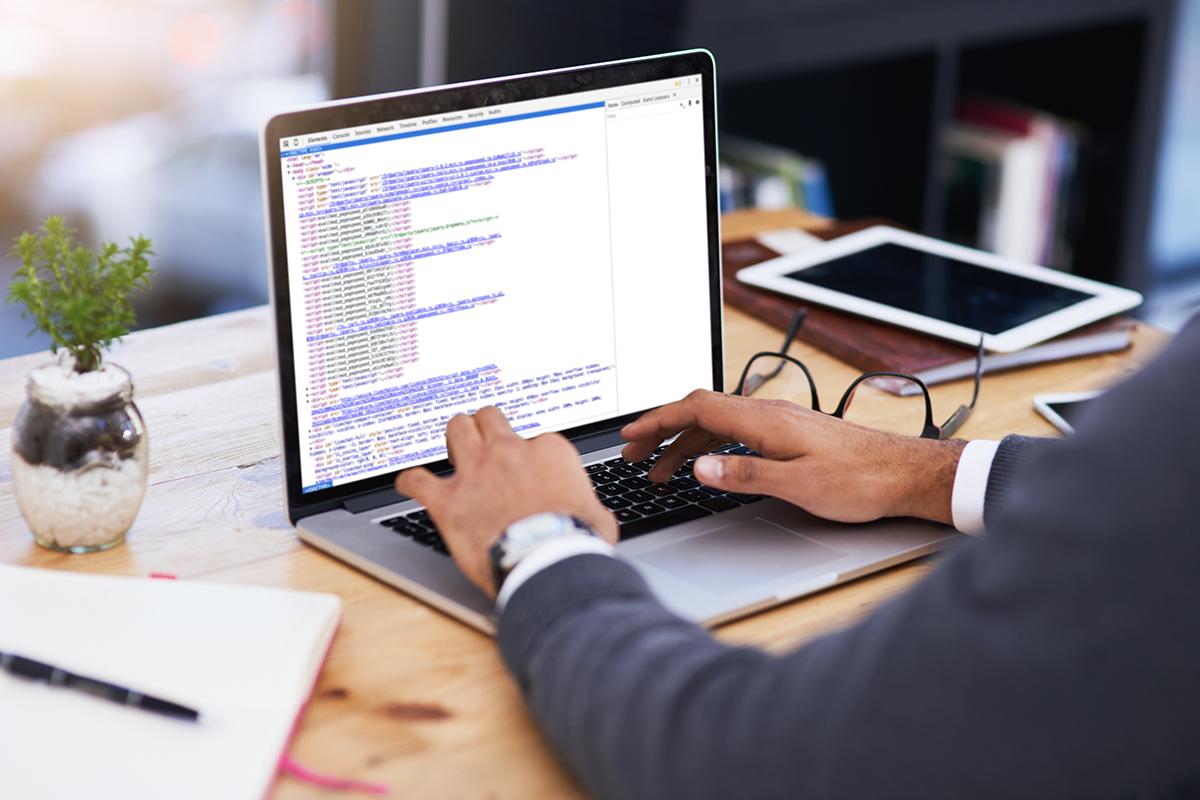A Meeting Agenda is a breakdown of activities and topics that attendees must perform or discuss at a particular time or during the meeting. A template, on the other hand, is a pre-made document that just needs to be filled out by you and thus serves the same purpose as a hand-typed document.
Agendas play a large part in enabling organizations to accomplish all-important subjects at a given meeting and ensure they are productive. However, achieving productivity requires adequate planning of activities and topics to be discussed. Writing one can help ensure a meeting runs efficiently and achieves its desired goals.
Attendees are provided with prior notice of different topics that must be covered during the meeting. The topics can be informational, where updates and presentations are made; discussion topics, which hold conversations on issues and make decisions on them; and action items, where updates are provided and discussions are held on the status of assigned tasks.
Free Templates
An agenda serves as a roadmap for successful meetings, providing a structured outline of topics and activities to be covered. Using pre-built templates offers several technical benefits. It saves you time and effort by providing a ready-to-use framework that ensures essential items are included. Our professionally designed templates are not only convenient but also completely free to download, enabling you to focus on the content and productivity of your meetings.
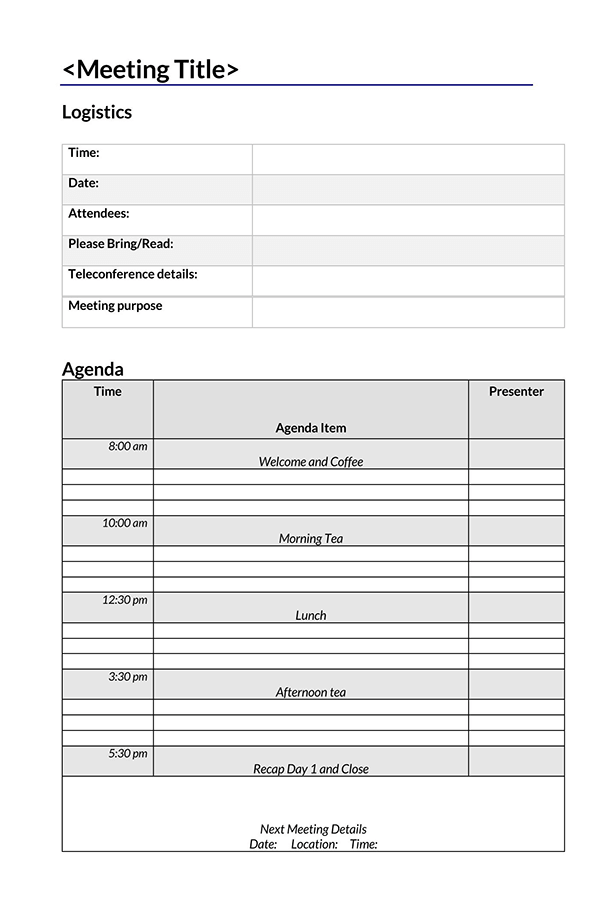
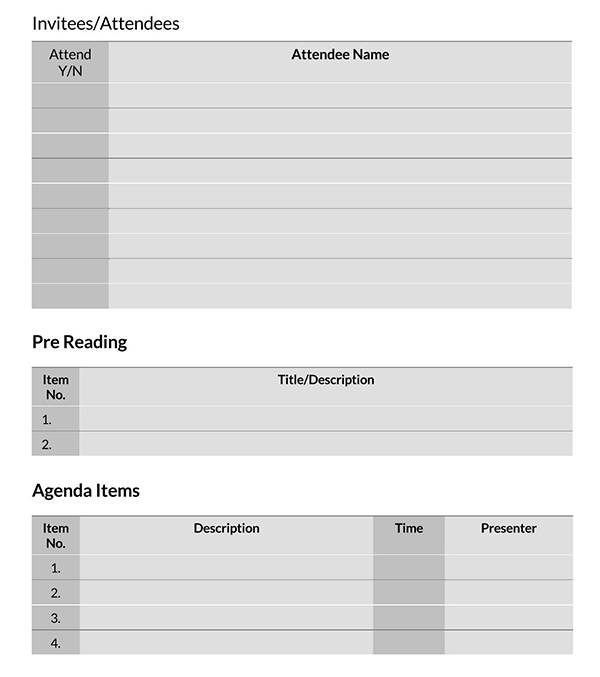
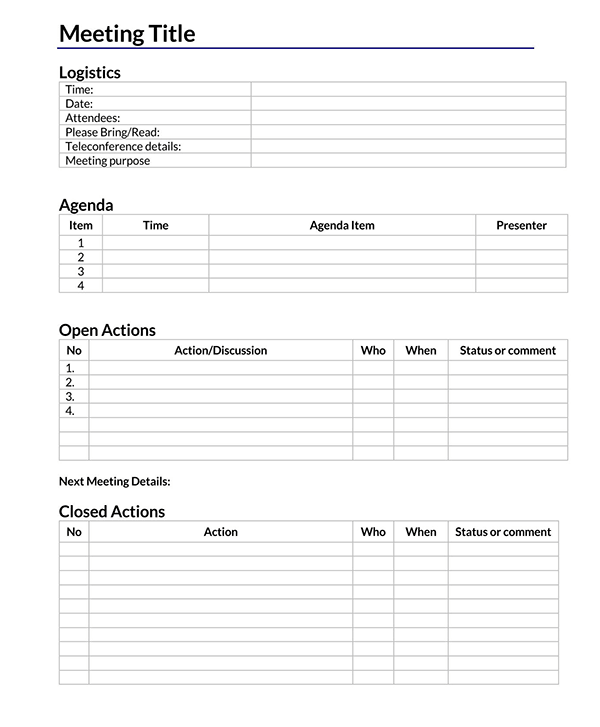
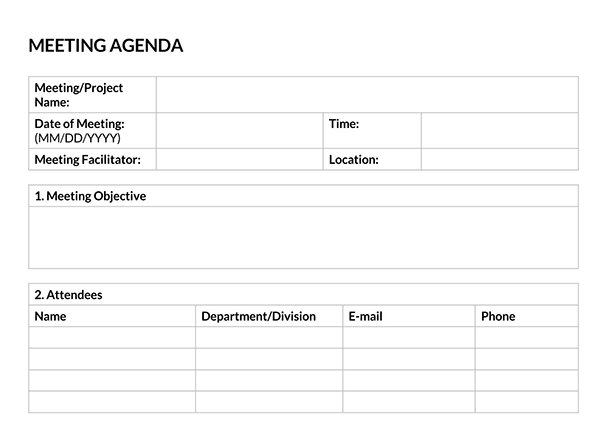
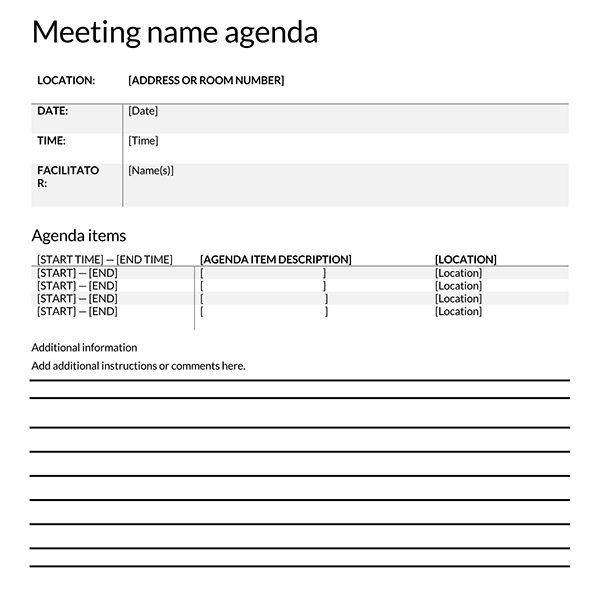
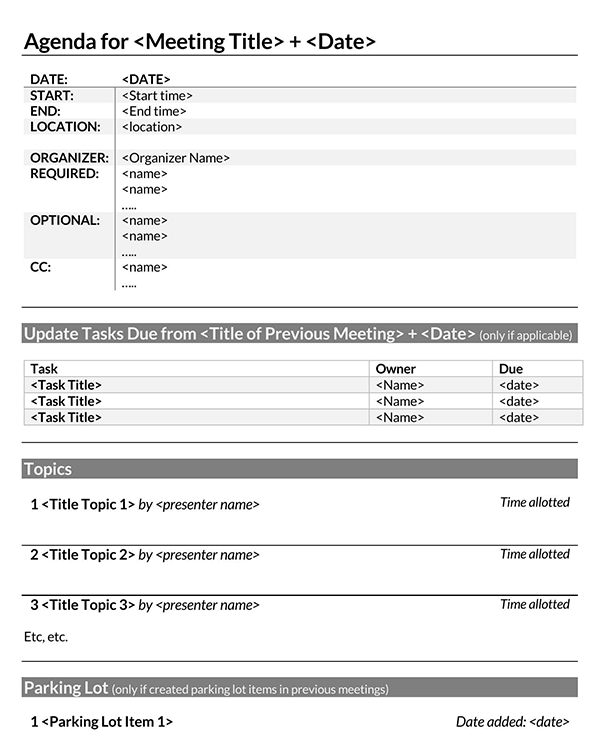
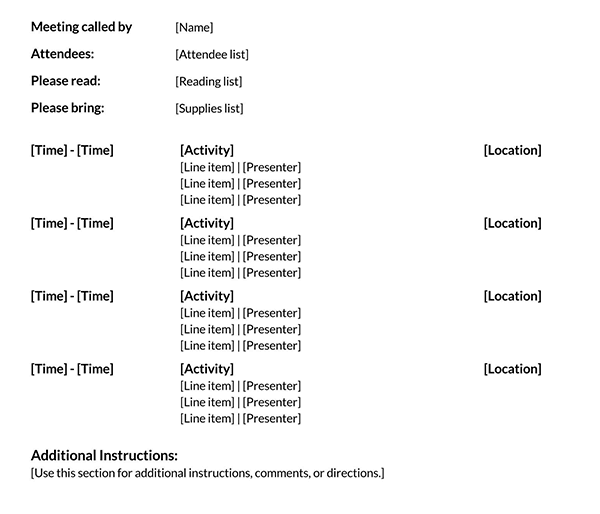
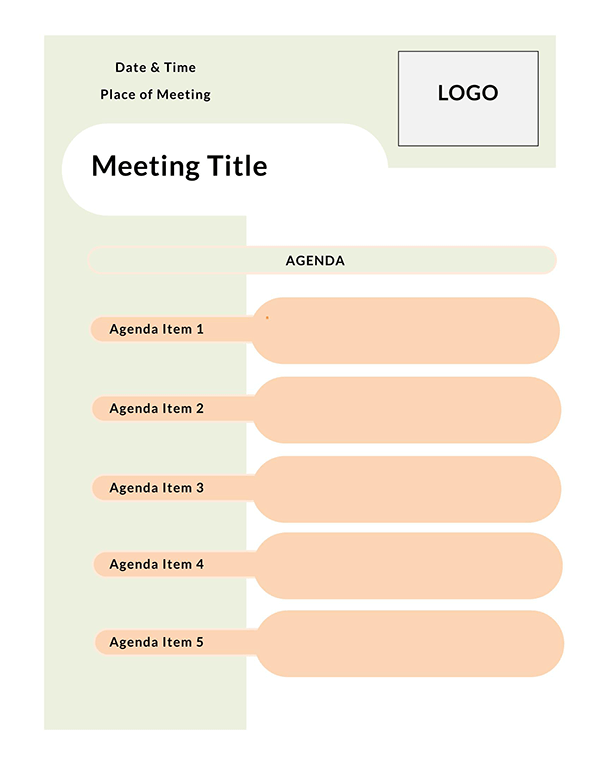
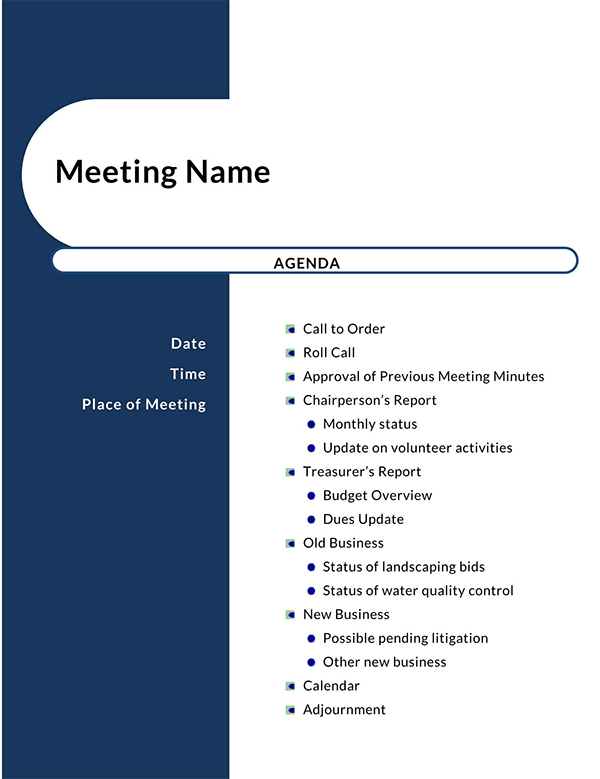
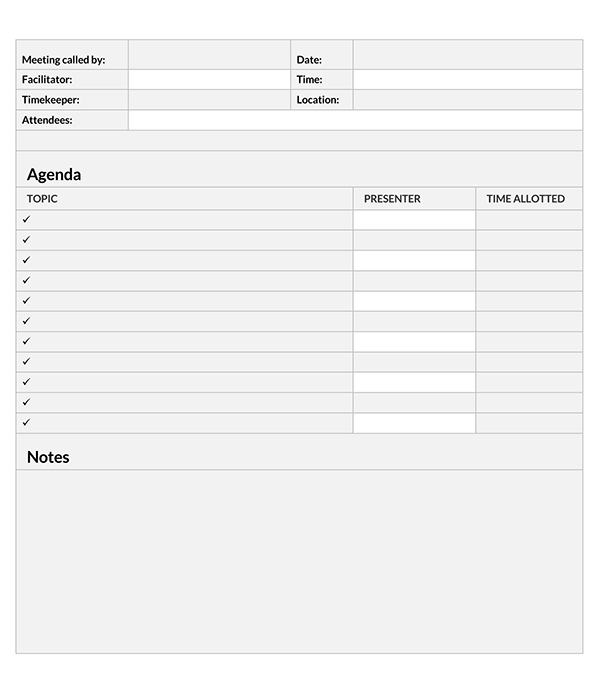
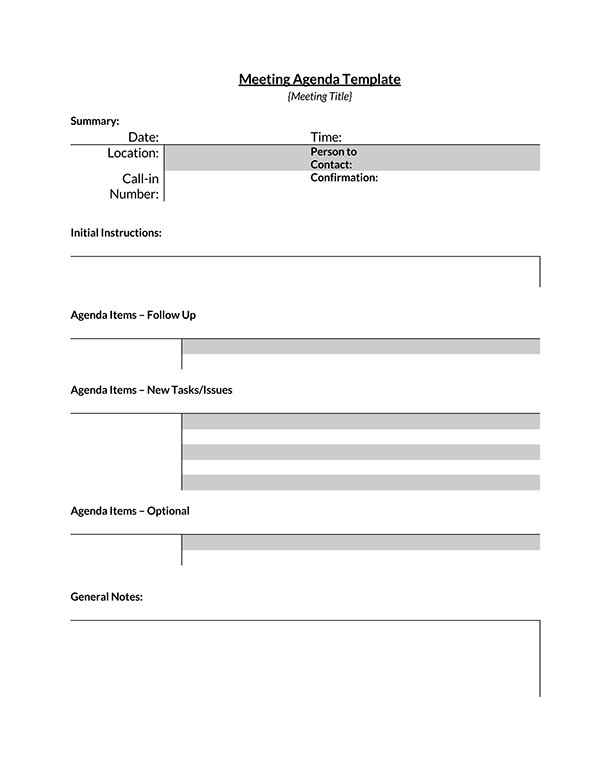
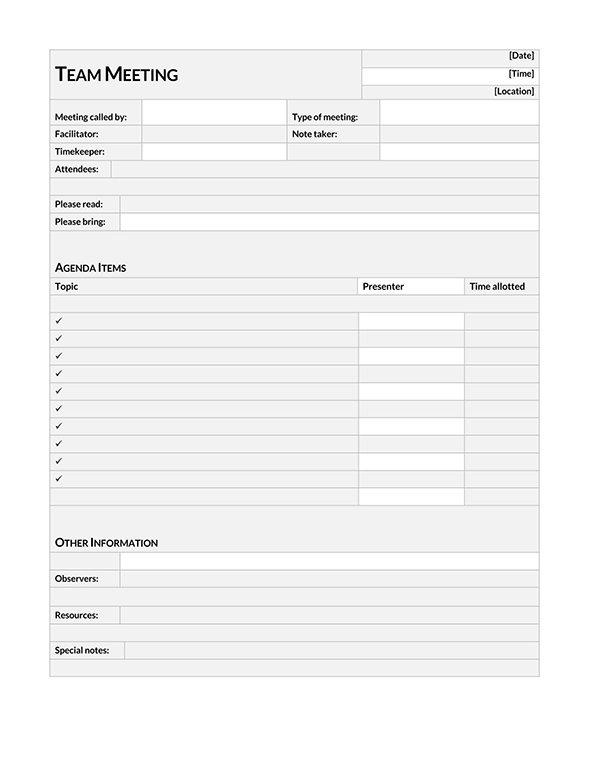
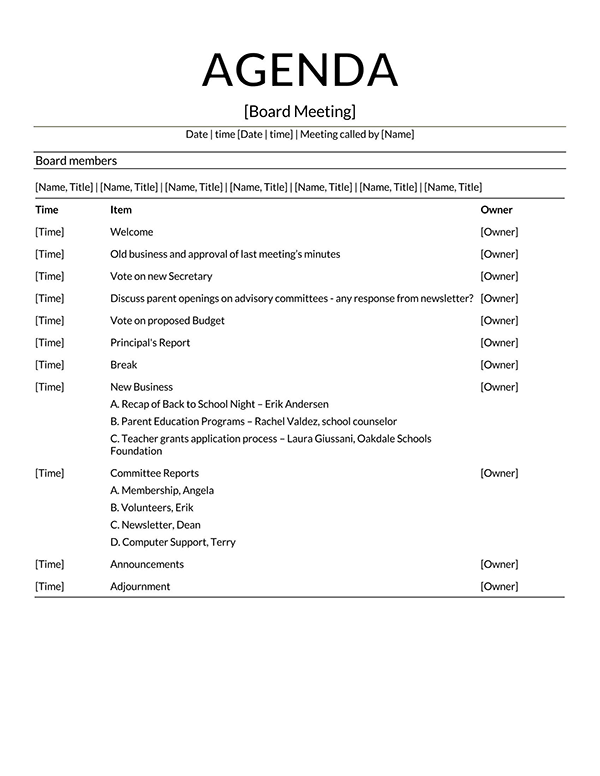
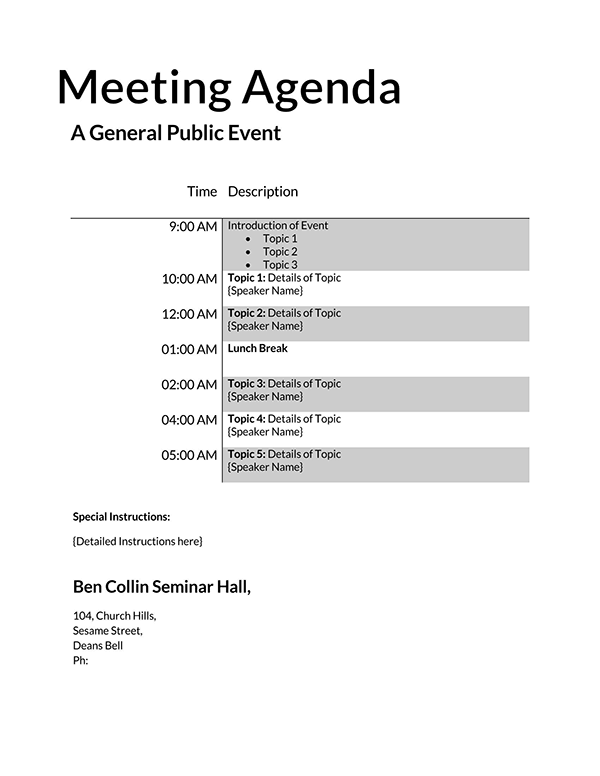
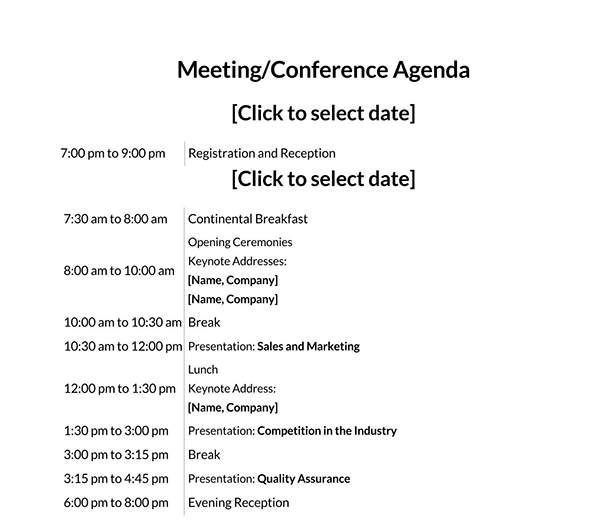
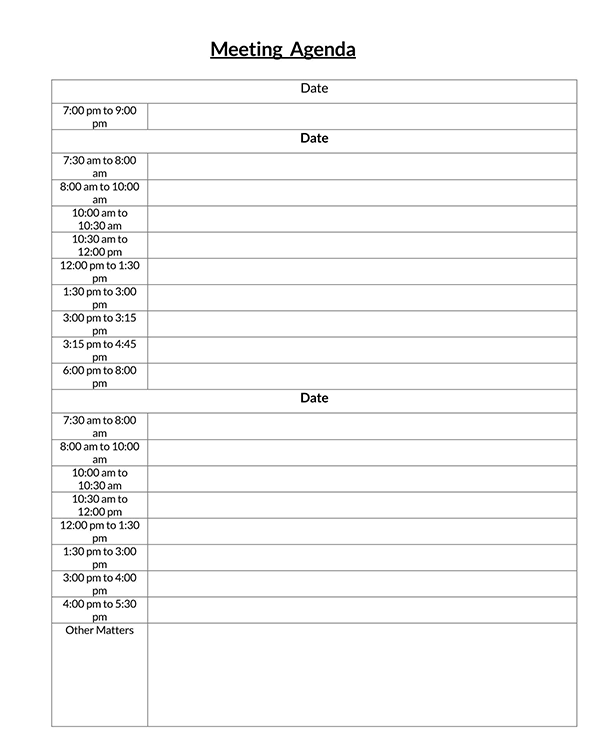
Importance of Having a Meeting Agenda
An agenda plays an essential role in helping an attendee discern whether or not he is needed in the meeting. Attendees can decide based on what will be discussed and whether the discussion topics are essential to their work. Attendees who feel their contribution would be crucial but cannot attend can plan to have a colleague convey their points even in their absence.
An agenda also helps attendees adequately prepare for the meeting. Attendees can gather the necessary documentation or prepare any presentations. It also enables attendees to think about the issues discussed.
It ensures that the meeting is well structured for the individual set to chair it. This helps ease the chair’s ability to keep it on track and within the outlined topics. Finally, an agenda helps the chair and attendees judge if the meeting is a success by assessing whether the goals have been achieved. It also helps determine whether future ones are necessary.
The following are types of meetings that can be organized with the help of an agenda:
Simple meeting
A simple meeting is a basic, replicable requirement. It is used when there are a few items to discuss or decide on. They are often short; therefore, the agenda set is usually straightforward and contains very few discussion topics.
Team meeting
A team meeting is where members of a team come together to discuss a particular topic or a list of topics. It helps build healthy communication among members of the team. A team meeting agenda template can be used to tackle important issues affecting the team or its work while also helping to keep members engaged in the discussions by ensuring that the organizer is not the only person stating points throughout the meeting.
Business meeting
A business meeting is one where two or more people come together to discuss company objectives and operations. They are often conducted in an office setting; however, video conferencing has made it possible for participants to join from anywhere. An agenda helps structure a business meeting, ensuring that it runs according to a well-laid-out procedure.
Weekly leadership meeting
A weekly leadership meeting is conducted at a designated time where leaders of every major function in an organization come together to discuss, bring up issues, and solve problems in their departments. Weekly leadership meetings help department heads gain insight into the work conducted by other departments and help them link issues that may affect the organization’s overall output. An agenda can help ensure that issues affecting the day-to-day operation of an organization are discussed.
Formal meeting minutes
Formal meeting minutes are official topics that are discussed. They are often written during or after the meeting takes place. The minutes are often highly detailed to ensure that the items discussed and decisions are conveyed. In addition, it helps highlight the items to be written in the minutes upon conclusion.
Board meeting
A board meeting is attended by the board of directors of an organization. It is held at definite intervals or required to review the organization’s performance, consider policy issues, discuss major problems, and perform the board’s legal business. A template helps ensure that all board members are well prepared for it.
Items To be Included in the Meeting Agenda
The items included in the template should ensure relevant topics are discussed. Therefore, the organizer must know which elements to include in it.
The following are the basic elements/items that should be included in it:
Title
The title is important in helping the attendee identify the kind of meeting. Therefore, the title should be written at the top of the template, and it should be center-aligned to ensure that it can easily be spotted.
A description of the purpose
Information on the purpose of the meeting should be provided. This will provide attendees with an indication of what it is all about.
The objectives of the meeting
It should contain the meeting objectives. The objectives will explain what the organizer hopes to achieve.
Meeting date and time
The date and time should be provided to help ensure that attendees are aware of when the organizer will expect them.
The meeting location
The organizer should indicate where the meeting will be held. This will ensure attendees are aware of the location.
Meeting type
This section should indicate the type of meeting that will take place. The organizer will indicate if it is brainstorming, assessment, or discussion. This will ensure that attendees come prepared.
The run time of the meeting
The meeting agenda should contain the start and end times. This will ensure that attendees know what time they can expect the meeting to begin and end.
Full list of attendees
The number of people expected in the meeting and their names should be indicated in the template for the meeting agenda. This will ensure that an attendee is informed of whether or not he/she is expected to attend the meeting.
Notes on preparation
The meeting agenda should contain instructions to be followed by attendees, things they should bring, and action items, including the last action and new action and their due dates. This will ensure attendees are well informed on what preparations they should make.
Other notes
Other instructions/information that attendees must be aware of should be provided in the meeting agenda.
note
There is no standard duration for a meeting; therefore, it can either be long/short. A long one can last a day or more. This is especially common for formal ones that are known to have away days. Therefore, it is important to indicate breaks. Short meetings may also have breaks; however, these breaks are often provided to allow attendees to discuss points among themselves.
Samples for Help
Following are a few templates and samples that may help you understand the structure of the meeting agenda:
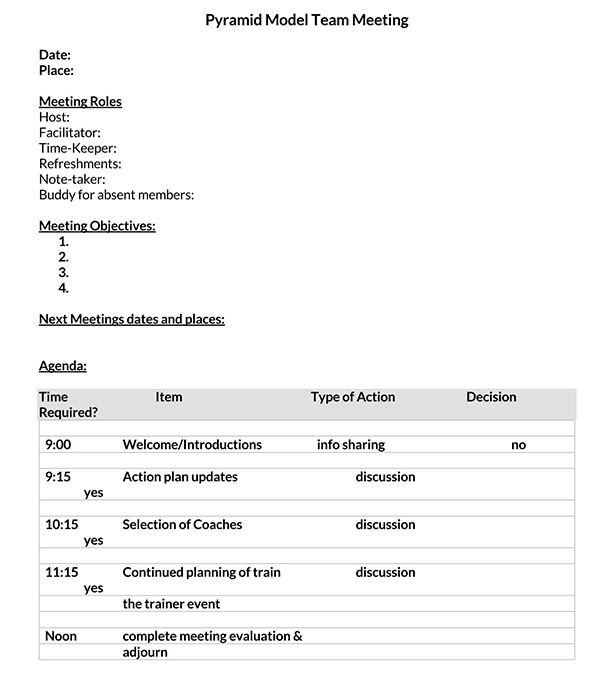
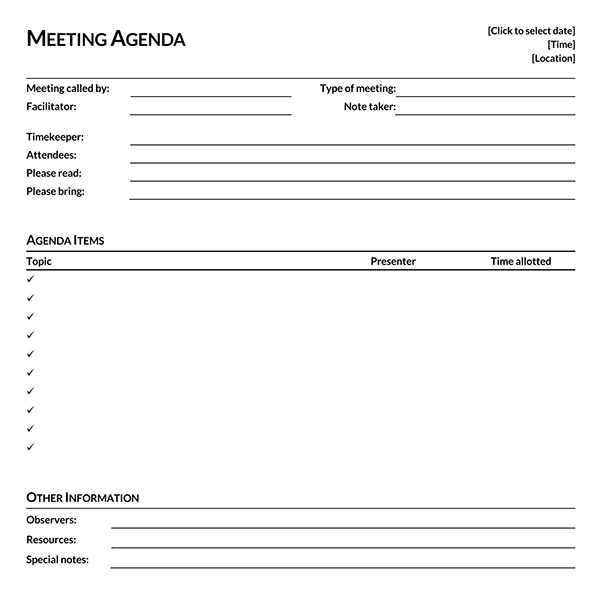
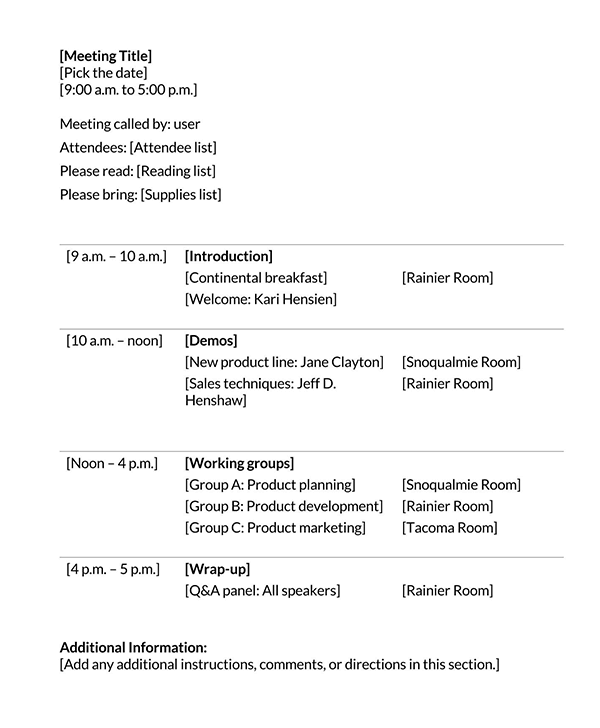
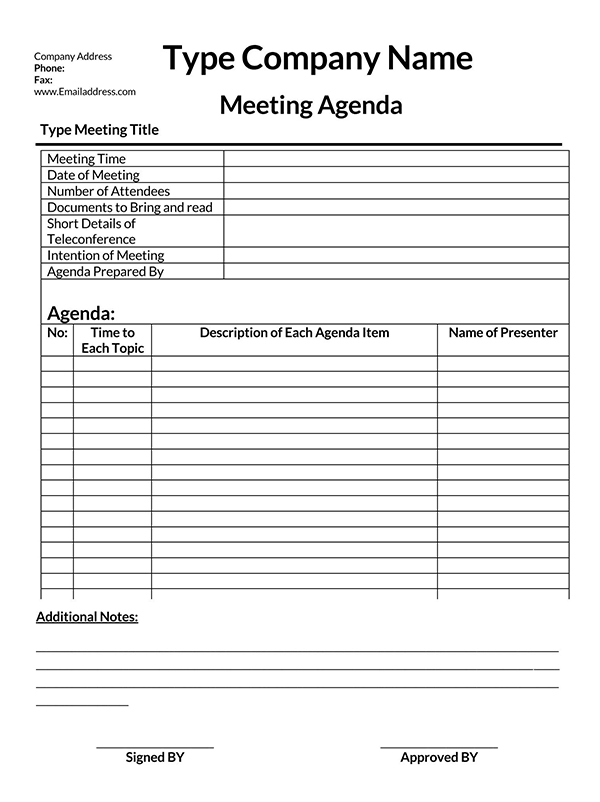
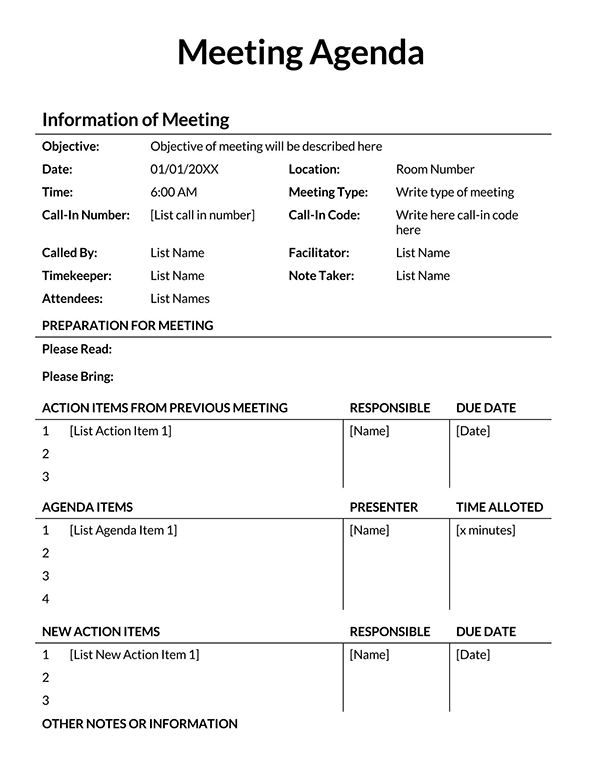
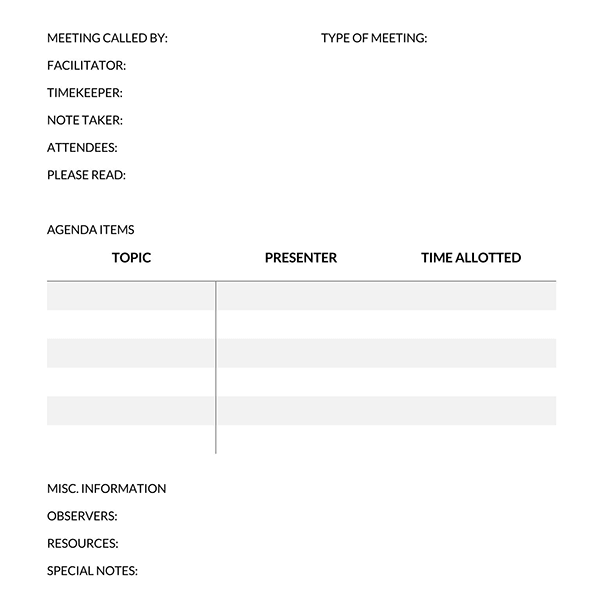
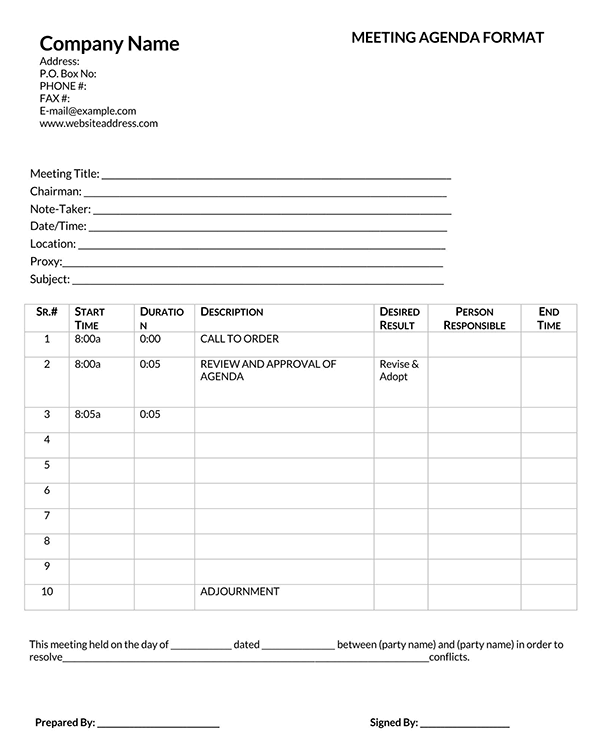
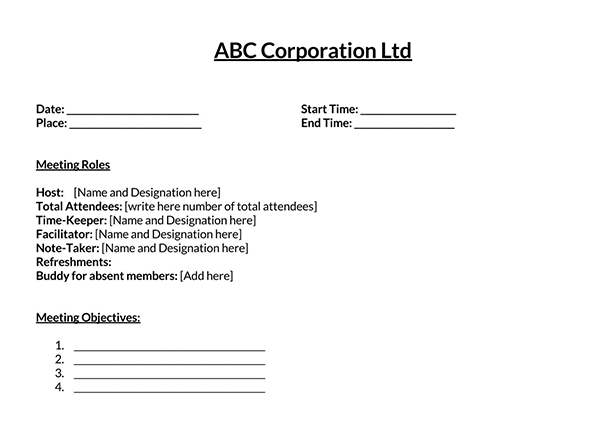
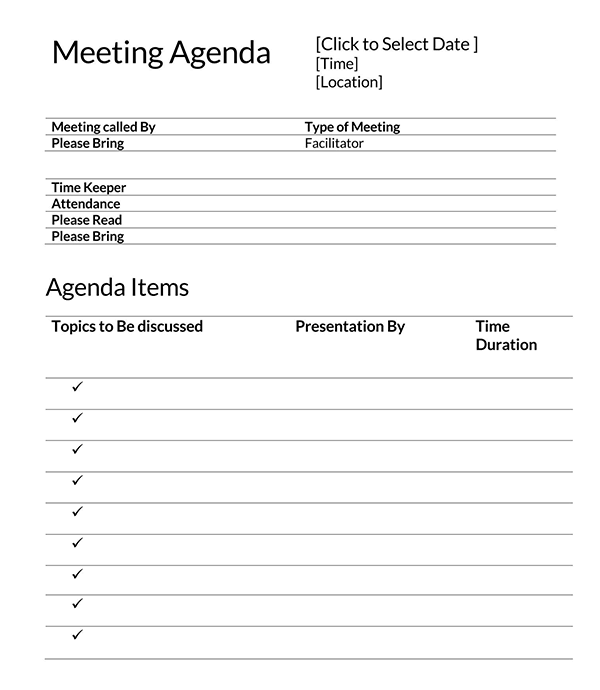
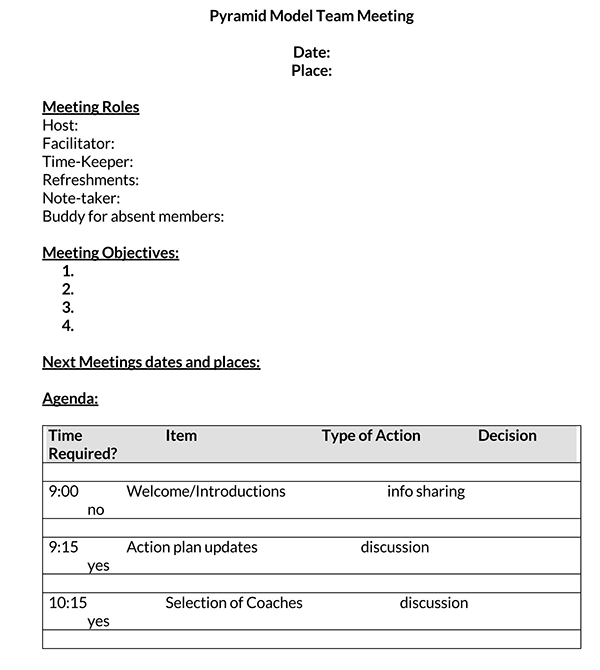
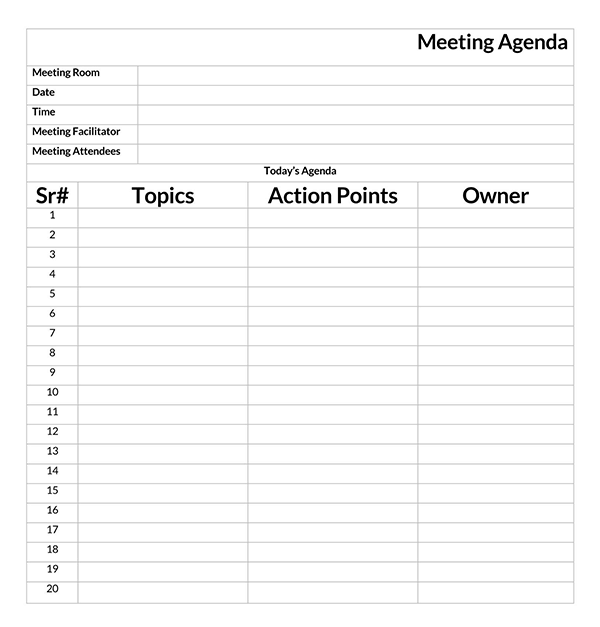
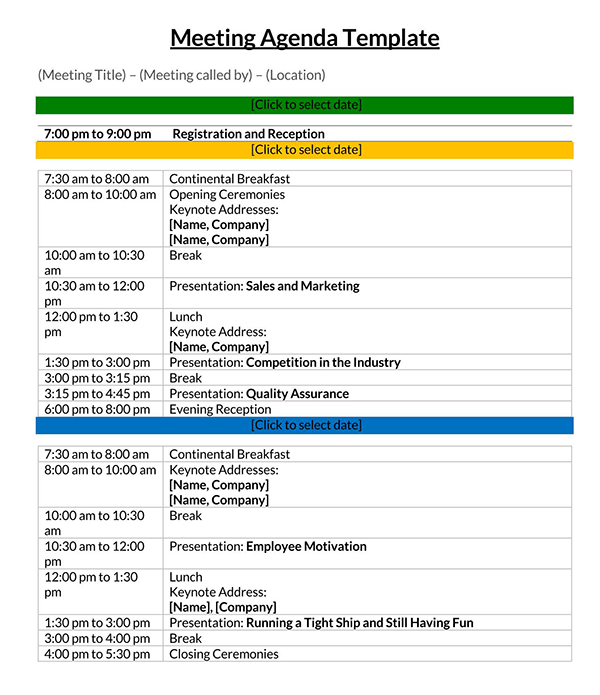
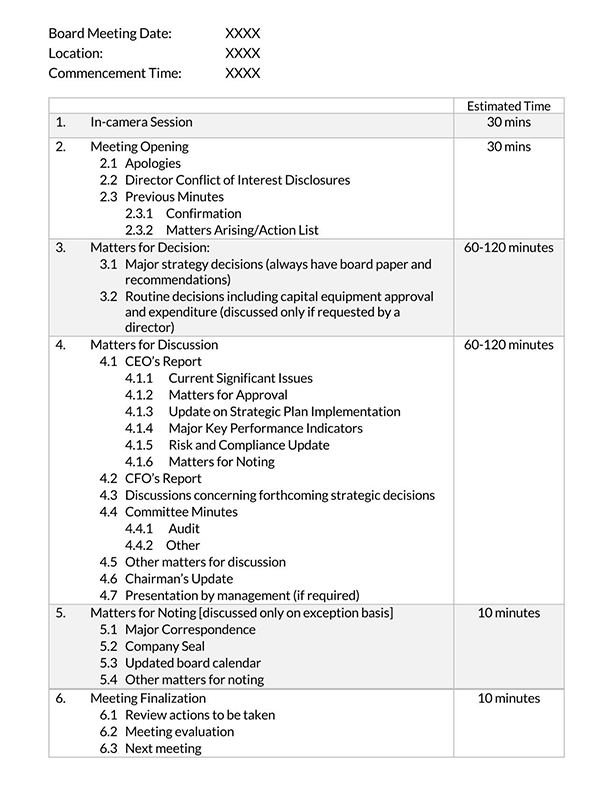
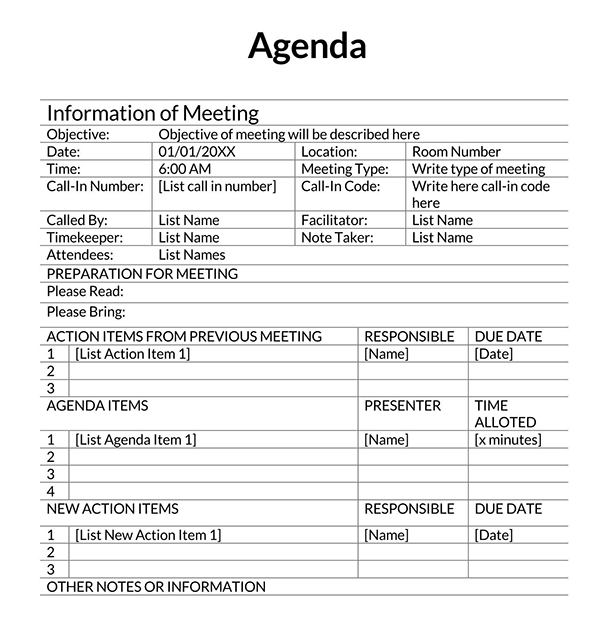
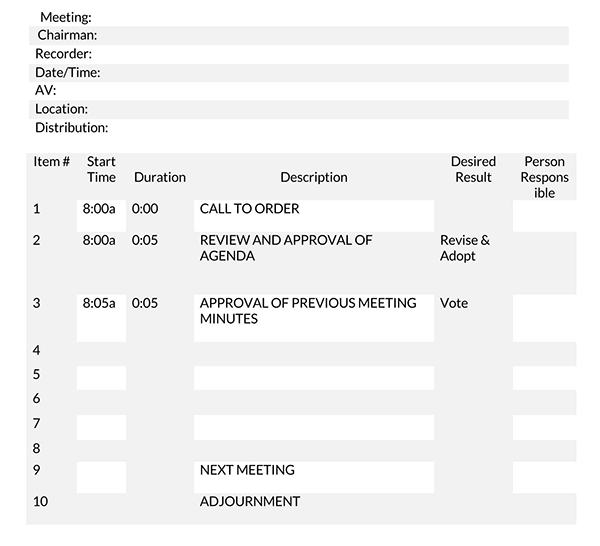
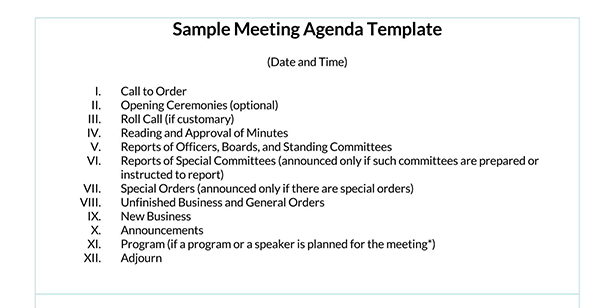
Outline a Meeting Agenda
Outlining an agenda can help create an order for tackling each topic, ensuring that everything is addressed. The organizer should begin his outline before the meeting starts to help ensure that several drafts are made and sent to attendees.
When writing an outline, the organizer should ensure the following:
- All discussion topics are written
- Attendees are consulted to provide their input
- Topics are organized by priority/importance
- All important information is provided
How to Fill a Meeting Agenda Template
A well-written agenda is drafted using a well-laid-out step-by-step process. Organizers must be aware of this process while creating one.
The following is the step-by-step process used to fill out an agenda template:
Define the goal(s)
The first step an organizer should take is to define the goal(s) of the meeting, as they will influence the topics to be discussed or activities that will take place in the meeting.
The goals should be achievable, like discussing a particular topic, such as the inflated company budget, or sharing information, such as progress reports. This helps ensure that the focus remains on important topics.
Take input from the participants
The second step an organizer should take is to consult his team about issues that need to be addressed. This will help keep the attendees engaged, as they will feel that their needs are being considered.
Organizers can ask for suggestions, questions, or items team members would like included in the agenda. A list should then be formulated to help ease the item selection process. Finally, the selected items in the list should be included in the template.
Enlist the problem(s) you want to resolve
Thirdly, the organizer should list problems that must be tackled and resolved in the meeting. The problems can be phrased as questions to encourage attendees to engage in discussions that help them come up with collectively agreed-on solutions.
EXAMPLE
If the purpose of the meeting is ‘Marketing and Advertising a New Product,’ the organizer could write, ‘What affordable advertising methods can we engage in?’, ‘How do we improve the effectiveness of our advertisements?’ or ‘What new marketing mechanisms can we embrace?’
Purpose identification of each task
The fourth step is to identify the purpose of each task written in the agenda template.
EXAMPLE
The purpose stated by the organizer may be to share information, obtain attendees’ opinions on a matter, or decide on an issue.
This will help attendees discern when their input is needed or when they must decide on an issue.
Calculate time duration
Next, an estimated time for each topic to be tackled should be allocated on the template. This will ensure attendees have enough time to cover all the issues. It will also help attendees ensure that their contributions /points are made within the time allocated.
Therefore, the entire meeting is not spent tackling only one topic; several issues must be discussed. Priority topics should be tacked first, or topics that are likely to take longer should be allocated more time. This will ensure that they are adequately dealt with to the satisfaction of all attendees.
Elucidate the leader of each topic
The organizer should then establish who will lead the discussion on each topic. This will help ensure that the people capable of leading the discussions are not caught by surprise, enabling them to be well prepared.
Conclude with a review
Finally, the organizer should allocate time for attendees to review the decisions and issues discussed. This will help remind attendees of the tasks they should undertake afterwards. The time allocated can also be used to evaluate the successes of the meeting and identify aspects that should be improved in the future.
Meeting Agenda Template
Meeting Agenda Title:
Date: Time: Location:
Goals:
Attendees:
Agenda Details
Start time-End time: Title of the first topic
Purpose :
Leader:
• Point A
• Point B
• Point C
Start time-End time: Title of Topic two
Purpose:
Leader:
• Discussion point A
• Discussion point B
• Discussion point C
Start time-End time: Title of topic three
Purpose:
Leader:
• Discussion point A
• Discussion point B
• Discussion point C
Start time-End time: Title of topic four
Purpose:
Leader:
• Discussion point A
• Discussion point B
• Discussion point C
Note :
Action Items
• Action item 1
• Action item 2
Conclusion
Preparing a meeting begins with creating an agenda. A template for one helps facilitate a productive meeting. It also helps ensure that the meeting has a clear goal, enabling attendees to focus on what is discussed or the decisions made. Therefore, organizers should always ensure that a meeting agenda is part of their management and facilitation practices.










